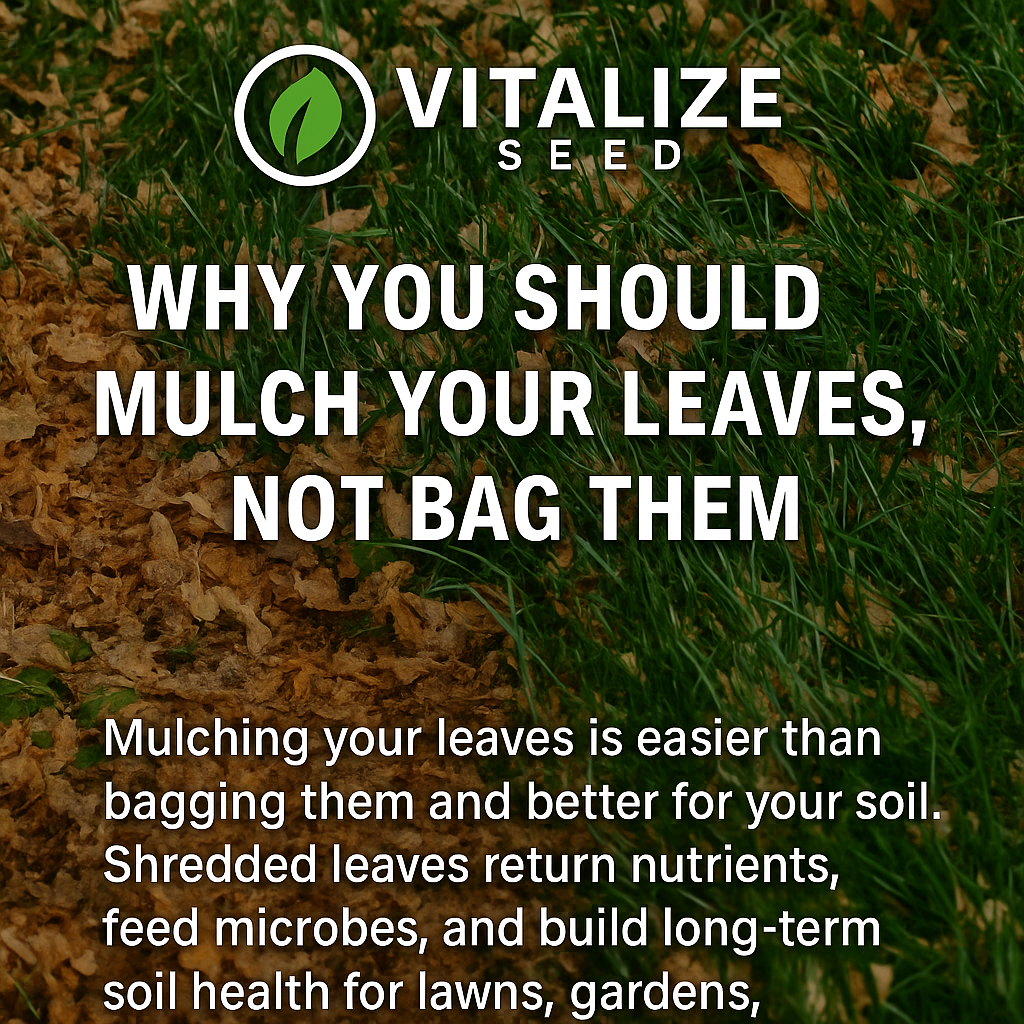
Why You Should Mulch Your Leaves, Not Bag Them
Share
Every fall, lawns across the country disappear under a blanket of leaves. For many, that signals hours of raking, bagging, and hauling them away. But what if those leaves weren’t waste at all? What if they were one of the best natural fertilizers you could give your soil?
At Vitalize Seed, we talk a lot about cycling nutrients and feeding soil biology. The same concept applies to your lawn. When you mow or mulch leaves back into the turf, you’re returning valuable nutrients and organic matter right where they belong.
1. Leaves Are Packed With Nutrients
Fallen leaves contain roughly 1–2% nitrogen, 0.5% phosphorus, and up to 2% potassium, nearly identical to many commercial fertilizers. As they break down, those nutrients slowly release into the soil, supporting turfgrass health and feeding the microbes that drive nutrient cycling. In fact, university studies show that mulching leaves back into the lawn can replace up to 25% of annual fertilizer needs.
2. Mulching Builds Better Soil
When you shred leaves into the turf, they don’t smother the grass, they feed it. The decomposing leaf matter adds organic carbon, improving soil structure, moisture retention, and microbial activity. That means stronger roots, better drought resilience, and fewer compaction issues over time.
At Michigan State University, researchers found that mulching a 6-inch layer of oak and maple leaves into established turf caused no negative effects on color, density, or spring green-up. Instead, it boosted soil health and suppressed weeds by covering bare spots where weed seeds would normally germinate.
3. It’s Better for the Environment
When leaves are bagged and hauled away, their nutrients are lost and often end up in landfills, where decomposition can release methane. Even worse, studies from the University of Wisconsin found that up to 80% of urban phosphorus runoff came from leaves piled on curbs for collection. Mulching eliminates that problem entirely by keeping nutrients on site, in the soil ecosystem they came from.
4. How to Do It Right
-
Mow often. Don’t let leaves pile up thick; mulch them when you can still see about half the grass blades through the chopped material.
-
Use a mulching mower or sharp blade. Smaller pieces decompose faster and won’t mat down.
-
Avoid wet or compacted conditions. Mulch on a dry day to prevent clumping.
-
Repeat until winter. Each pass adds more organic matter and nutrients back to the soil.
5. How This Applies to Food Plots and Gardens
The same biological principles hold true in food plots and gardens. If your fall plots are covered in leaves, don’t feel like you have to clear every inch. Leaves are rich in carbon and micronutrients that benefit soil biology as they decompose.
If the layer of leaves becomes so thick that it starts to smother young seedlings or cool-season cover crops, simply remove or rake away enough to allow sunlight and airflow for plant growth, but realize that the remaining leaves are helping to build long-term soil health.
For perennial clover plots or similar systems, mowing can be a great tool to speed decomposition. When you mow over the leaves, the clover clippings provide a low-carbon, nitrogen-rich material that helps balance the high-carbon leaves. This creates an ideal carbon-to-nitrogen ratio for microbial breakdown and nutrient cycling, very similar to the process in well-managed turf systems. Over time, this practice builds soil organic matter, supports earthworm activity, and keeps nutrients where they belong in your soil.
The Takeaway
Nature doesn’t waste nutrients, and neither should we. By mowing or mulching your leaves instead of throwing them away, you’re recycling valuable fertility, building healthier soil, and closing the loop in your landscape’s nutrient cycle.
Healthy soil is the foundation for healthy plants, whether that’s your backyard lawn or your favorite Vitalize Seed food plot.
Vitalize Tip:
Want to take it a step further? Apply Bio-Charge or Revive RX after leaf mulching to accelerate decomposition and feed soil microbes. You’ll convert those shredded leaves into stable organic matter faster, fueling your soil biology for next spring’s green-up.
